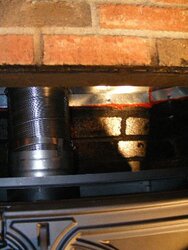Hi all,
I have a question I hope someone knows something about. We've had our first blast of cold air since I put in my insert, and I noticed that with the snow, my gutters are now jammed with ice on the same side of the house as the fireplace. The house is one story with an unfinished attic that is fully insulated and vented. I'm wondering if the chimney is getting warm enough to heat the attic melting the snow causing the ice damn. If so, how do I stop it? The chimney is brick masonry with a 6" liner and if I recall correctly, the brick is exposed in the attic. I never had this ice problem with the old open fireplace and I'm getting worried I may have a big repair bill if I can't figure this out. Thanks for any advice!
I have a question I hope someone knows something about. We've had our first blast of cold air since I put in my insert, and I noticed that with the snow, my gutters are now jammed with ice on the same side of the house as the fireplace. The house is one story with an unfinished attic that is fully insulated and vented. I'm wondering if the chimney is getting warm enough to heat the attic melting the snow causing the ice damn. If so, how do I stop it? The chimney is brick masonry with a 6" liner and if I recall correctly, the brick is exposed in the attic. I never had this ice problem with the old open fireplace and I'm getting worried I may have a big repair bill if I can't figure this out. Thanks for any advice!



